Writing a CHIP-8 interpreter in CHIP-8
Een CHIP-8 interpreter, geschreven in CHIP-8
Dit artikel is alleen beschikbaar in het Engels. Sorry daarvoor.
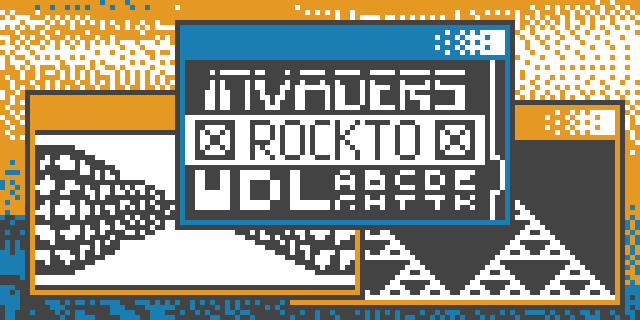
This is the development log of Chipception OS, a CHIP-8 and SUPER-CHIP interpreter written in XO-CHIP. My submission to Octojam 10. Because CHIP-8 interpreters have been written in every programming language and the platform also deserves one written in CHIP-8 itself! 😄
Wait but why..?
I’ve been thinking about writing a CHIP-8 interpreter in CHIP-8 for almost two years or so. It’s just such an insane idea that I can’t help but find myself attracted to it.
To be clear: there is absolutely no benefit to just having a CHIP-8 interpreter written in CHIP-8. It would only allow you to run the exact same programs, but slower and probably with more unexpected bugs. Also, it’s quite the engineering challenge to make it actually work. So it’s a significant investment of time that brings absolutely no tangible benefit. Sounds like my kind of project! 🎉
However, thinking about this a bit longer, there are a few cool things we could do with such an interpreter. One is adaptation: it could act as a mediator between programs and interpreters that don’t play nice otherwise, without modifying the original program or the interpreter running it. A CHIP-8 program that relies on a version of CHIP-8 (or one with specific quirks) that you don’t support in your interpreter could be wrapped in a CHIP-8 CHIP-8 interpreter, and run just fine in your interpreter.
Another kinda cool thing that I wanted to experiment with is multithreaded CHIP-8. A CHIP-8 interpreter written in CHIP-8 could theoretically run multiple CHIP-8 programs in parallel on a single host interpreter. This has no real benefit, but it would be something cool to play with. It also touches on another itch that I have had for a while and that kinda needed scratching: writing an operating system for CHIP-8.
Last Octojam sysl made a program that was a mock-up of a CHIP-8 PDA operating system, that they called BIM. It makes sense for them to model a “CHIP-8 OS” on a PDA-type device, since you can’t really “download” or “install” new programs into a running CHIP-8 interpreter. PDAs used to come with a fixed set of “applications” like a calendar or a calculator that were just baked into the ROM of the device, each just running directly on the hardware and taking over full control of the CPU.
However, when I dream about a “CHIP-8 OS”, I think about something that resembles the early Unixes, that can run programs in “user mode”, with a “kernel” that can do “scheduling” or kill misbehaving programs and maybe some way for programs to communicate with each other.
So maybe, just maybe, starting with a CHIP-8 interpreter in CHIP-8 is the first step on the journey towards a true CHIP-8 operating system. One that runs CHIP-8 programs, that you can switch between or run in parallel. Maybe a few custom opcodes could allow for the program to communicate with the host OS or other programs?
So I drew this image of a four colour XO-CHIP program running a “desktop” GUI with two CHIP-8 programs running in parallel to inspire myself:
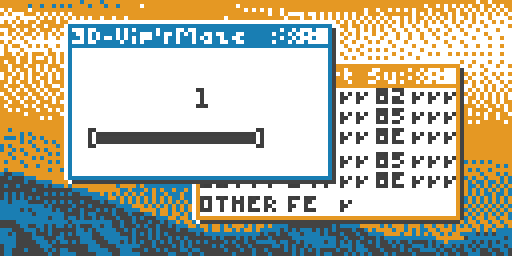
Alright, enough rationalizing an irrational project and having crazy pipe dreams about its potential, let’s get to coding 😉
Getting started
I came up with the project name “Chipception”, short for “CHIP-8 Inception”, and got to work.
So what are we up against?
Writing a CHIP-8 interpreter isn’t too hard. This will be the fourth time I write one. But writing one in a language that is also the target language brings both a couple of challenges and a couple of shortcuts.
The good news is that many opcodes can just be passed on to the host interpreter as-is. To AND two registers, we just ask the host to AND two registers. Save the result, save the flag register, and we’re done (if we’re just ignoring quirks).
The bad news is that we will actually need all the registers that CHIP-8 provides us with for running the interpreter. So every opcode will need to operate on virtual registers in memory, adding quite a lot of overhead.
Next to that, it’s super hard to predict how a CHIP-8 program will use RAM. So we can’t gracefully “share” the 4K of memory space, without a crazy amount of overhead. Our interpreter would have to keep track of which parts of RAM are being written to and do some kind of memory management. But even then: many of the worth while ROMs for CHIP-8 are 80+ percent of the available storage. In those cases there’s just not enough space to add the interpreter at all.
Also; there’s this little thing called self-modifying code, where a CHIP-8 program modifies itself to achieve some goal. For some programs, this trick may depend on the fact that a reset of the program loads in a fresh new version of the ROM. So this means that to do it right and be a proper interpreter, we have to make a copy of the ROM before we start execution.
Because of these memory requirements and the CPU overhead I very soon had to accept the fact that this was going to be an XO-CHIP project. And that it will only interpret systems that require less memory than XO-CHIP, like CHIP-8 and SUPER-CHIP.
Getting things going!
The first version of this program came together in a little over one evening: initialize virtual registers, fetch an opcode, branch correctly on the opcode, proxy all the CHIP-8 instructions to operate on the virtual registers. I also added in a few quirks for good measure and my CHIP-8 CHIP-8 interpreter was running and passing most of the available tests.
The quirks test was
the hardest to get right, because I was targeting CHIP-8 and SUPERCHIP, but my
host system was using XO-CHIP quirks. So my Chipception interpreter needed to
implement versions of the required quirks, using the XO-CHIP quirks. Especially
getting the sprite opcode to clip properly on the edges of the screen was a
bit of a pain. It also required quite a few cycles per frame.

So after doing quite a lot of work on this project, I arrived at this rather unsatisfying point. I could successfully run a single CHIP-8 or SUPERCHIP program in an XO-CHIP interpreter. Just a little bit slower. And precisely no one could actually see the difference with not having done all of this extra work.
One is none
So to get some return on investment, I decided that I would immediately take this project in the direction of running multiple interpreters in parallel. If you can run multiple programs next to each other, surely that’s obviously something new. Something different.
Because all my code was already operating on virtual registers in memory, it
was actually not that hard to get it to run multiple virtual CPUs in parallel.
Making use of the fact that SUPER-CHIP hires is twice the CHIP-8 lores
resolution, I could pretty quickly get Chipception to render this:

Which is clearly much more cool! A single unmodified CHIP-8 interpreter that’s running four distinct ROMs at once? Now we’re talking! 😄
However, these programs are chosen quite carefully. If any program tries to clear the screen or shift it, everything totally breaks. Also, when you press a button, all programs register the same keypress. Which is probably not very useful behaviour.
Virtualising the display turned out to be a lot more work than doing the CPU. I had to – once again – write a custom double buffered rendering system with a custom sprite drawing routine in CHIP-8 that could draw 8xN and 16x16 sprites as well as get all the quirks right. Then I had to implement the other opcodes to operate on those buffers. Just so that each interpreter could have its own isolated display behaviour1.
And then I needed to composit those discrete display buffers together to form
the full display output. Because I wanted to be able to move virtual windows
over each other, those windows also needed to occlude each other. The normal
sprite behaviour does not support that kind of rendering. So the composite
step also renders everything to yet another virtual display buffer, that is
then finally drawn to the screen.
After all of that, I decided it was time for some lighter work: I wanted to render some colourful borders around the virtual windows, to make it look a little bit more like my inspirational drawing. How hard can it really be to render a few lines and squares to a virtual display buffer in an unusual memory lay-out?
Yeah. So that took me way longer than I care to admit. I put the project down for a couple of days, just because I was too annoyed I couldn’t get the damn routine to draw a bloody horizontal line 😂 But after taking a few breaths and a couple of days off, I managed to produce some primitive drawing routines and now all of a sudden Chipception could do this:
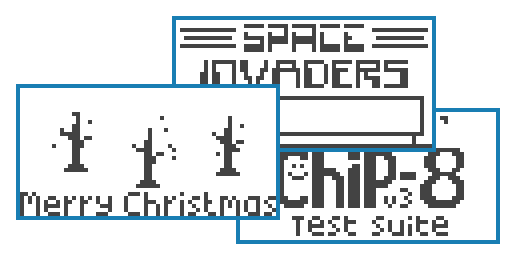
This is still just a single CHIP-8 ROM running in Octo, with a custom colour scheme. This is starting to go somewhere!
Note 1: I never properly finished the buffer scrolling opcodes as the ROMs I chose to run in this interpreter didn’t use them. In the end I removed the scrolling behaviour entirely to save executable space. So in that sense it’s not a “full” SUPER-CHIP interpreter, unfortunately. It can be done, but only at the expense of leaving out some other features.
Managing windows
Now that I had all these cute little windows into CHIP-8 programs, I felt it was time to make them interactive. I started by introducing the concept of a “focussed window”. The windows were given an ordering so they could behave like a stack, like people are used to on their regular computers. The window “on top” is then considered to be “focussed”. Inspired by my concept art, I made the focussed foreground window blue and the other windows orange.
Now that there is one window that’s clearly “active”, we can do fun things with that. The most important thing: the interpreter in the focussed window gets keypresses, and the others do not. So by switching the focussed window, you also change which program you’re interacting with as a user.
Speaking of switching windows, I implemented a crude “Alt-Tab” functionality to
cycle through the windows on the screen. The CHIP-8 key A (mapped to Z on a
Qwerty keyboard), being in the bottom left corner of the keypad, became a sort
of “function key” for interacting with Chipception, instead of the currently
focussed ROM.
These are the key combos I wrote to begin with:
| CHIP-8 keys | Qwerty keys | Function |
|---|---|---|
A - 1 |
Z - 1 |
Cycle through windows (“Alt-Tab”) |
A - 4 |
Z - Q |
Quit focussed interpreter |
A - D |
Z - R |
Reset focussed interpreter |
A - 5 |
Z - W |
Move focussed window around |
I later changed Z - Q to Z - C because I kept accidentally quiting ROMs
when I tried to cycle through them 🙈
Moving windows around is done with either WASD or the cursor keys on a
computer keyboard, or 5, 7, 8 and 9 on a CHIP-8 keypad. Pressing our
function key A / Z again returns the system into normal mode.
Admittedly, the combinations make a lot more sense on a Qwerty keyboard than on a CHIP-8 keypad. See underlined letters. But I wanted to use combinations that I could actually remember 😅
So now I could switch between CHIP-8 windows, move them around and interact with the CHIP-8 ROMs running in them 🎉
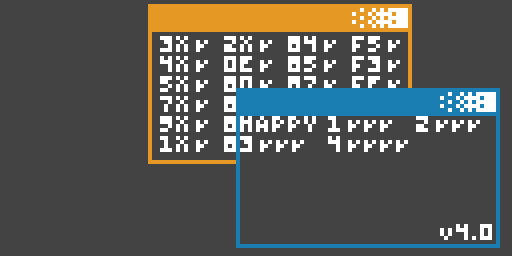
Running out of space
Unfortunately, at this point I ran into my arch nemesis. Space constraints.
Last year I battled this foe with Bad Apple!! in XO-CHIP and the year before with 3D VIP’r Maze for the original Cosmac VIP interpreter. For Bad Apple the challenge was fitting the whole music video, both video frames and sound, into the total XO-CHIP memory size of 64KB. With 3D VIP’r Maze the challenge was fitting the game and its graphics and game data in the lousy 3.2KB of memory that the VIP interpreter allows for ROMs to be.
This year, truth be told, I really wasn’t expecting to run into any significant memory issues. This is an XO-CHIP project. I wasn’t doing anything stupid like trying to compress a music video down to an insanely small size. I only have a few ROMs to load, I need some free memory to manage and I have the code for Chipception itself. If it doesn’t fit, I just include fewer ROMs. What could go wrong?
Well, after just a couple of days of actual development, I hit the dreaded 3.5KB executable code limit. It turns out that after four years of this stuff I got pretty fast at writing lots of CHIP-8 assembly code…
What’s the 3.5KB executable limit?
CHIP-8 ROMs can be as big as you like. You can append bytes to infinity. The problem isn’t making the ROM bigger, it’s being able to make use of your bytes.
CHIP-8 has something known as the index register. The index register is used to point at memory and then perform operations with the memory being pointed at. The index register is set using a 16-bit opcode that looks like this in hexadecimal:
0xAnnn
The nnn here is a placeholder for the address we want the index register to
point at. And nnn is 12 bits wide. So CHIP-8 can only address 2 to the power
of 12 bytes, which is 4KB. Subtract from that the fact that CHIP-8 programs
start at memory address 512, and we’re left with a maximum adressable ROM size
of 3.5KB. Anything above that we simply can’t point to to make use of it.
The same applies to the opcodes for jumping and calling subroutines, which look like this respectively:
0x1nnn0x2nnn
Here nnn is a placeholder for the address we want to jump to or call into. So
just like with setting the index register, we can’t go anywhere that’s outside
the 3.5KB boundary.
XO-CHIP
adds a double sized opcode (0xF000 0xnnnn) that can set the index register to
a 16-bit value, allowing us to address 2 to the power of 16, which is 64KB.
Minus the same 512 bytes, but that’s not as big of a deal at that scale. But
XO-CHIP does not give us 16-bit jumps or subroutine calls. Which creates the
interesting situation where we can have plenty of space left “in the ROM”, but
we can only use that space for storing data. Not for storing code.
That’s the 3.5KB executable limit.
The sharp observers among you are now probably screaming two things at your screens:
- Just move your data to higher addresses, so you can make maximum use of those 3.5K for code!
- If you can’t jump above the 3.5K limit, you can still run code there. How about you just unroll some loops or something and make your code go on forever!
To the first, I say: I’m already doing just that. One of the main reasons that I wrote my Octopus preprocessor is that I wanted to have an easy way to mark part of my CHIP-8 program as data, and have it automatically moved to the end of the ROM. That’s working wonders. So yes, I have actually written 3.5KB of executing code.
To the second: that sounds great, but without jumping we basically lose any meaningful flow control in CHIP-8. Because all the conditional opcodes only jump over a single instruction, and in many cases you really need that single instruction to be a jump (over a longer block of code). You could jump over subroutine calls and store the subroutines below the 3.5KB limit, but in practice that doesn’t buy you much.
In all honesty, I’m not 100% convinced that CHIP-8 without jumps or subroutines is even Turing-complete…
Also, some XO-CHIP interpreters wrap the program counter around from 0xFFF to
0x000, or don’t support returning from a subroutine to an address that’s more
than 12 bits. So realisticly, we just have to keep our code below the 3.5KB
limit.
So now what?
Time to optimize. Already. For every feature I add from now on, I will also have to cut some dead weight.
Looks matter
One thing I remembered was that I already added code to show a background image, but I couldn’t get my background image data in memory in the right format. So until now I was clearing the screen, for which I had also added a separate routine. If I fixed my background data format, I could remove the screen clearing code.
So I manually created the right background image layers in the GIMP to import into my project with the Chipcode image loader plugin.


Next I had to add an 8 by 64 pixels mode to the image loader, which it turns out Gulrak’s excellent Chiplet assembler already supported too. I then also wanted to fix some annoyances with the window shadows, so that the windows stick out enough from the background. Just like in my graphical mockup.
And voila! I added a feature while also throwing out a routine that I didn’t need anymore!
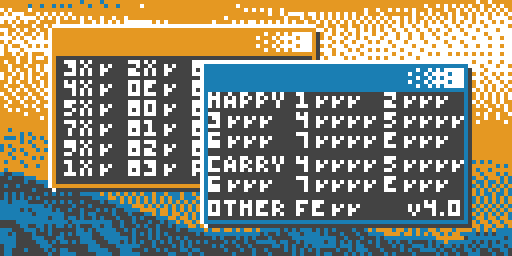
Compare that to the mock-up I made at the start of this project! I was quite amazed that I had come this far already 😄
After some feedback from the #chip-8 channel on the EmuDev Discord I was not entirely convinced that these window shadows are the best looking option. Here are some alternatives I drew:
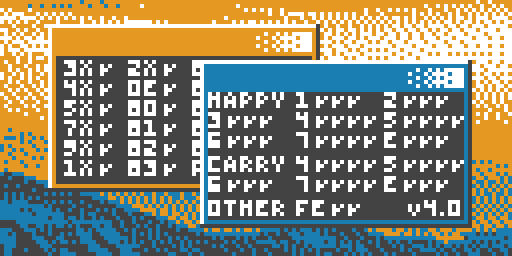
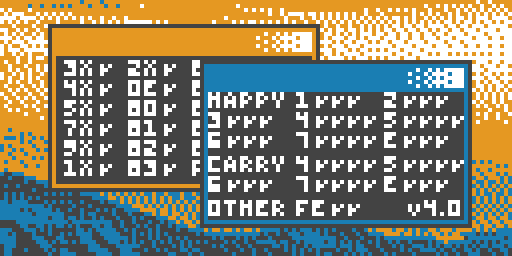
After messing with the different alternatives in the code a bit, I realised that I could implement the last design with the smallest number of instructions. Changing the design again saved around 50 bytes 🎉
Launching programs
If the idea is for this thing to be a “CHIP-8 operating system”, then we should at the very least be able to launch programs. But I was almost out of executable memory, so writing a start menu or another graphical program launcher was out of the question.
Lucky for me, I was already considering having “Chipception programs” that could achieve some Chipception specific things with custom opcodes. So I quite quickly realised that I didn’t really need a whole interface in my executable space, all I really needed was an opcode for launching a new program. Then I could write a ROM that would actually be the interactive interface for the user.
One of the hardest things to figure out was how the launcher ROM could know which ROMs are available to Chipception. The solution turned out to be quite simple, albeit not super clean.
When loading a ROM, Chipception just lazily copies data from the starting address of the ROM all the way until the memory of the virtualized interpreter is full. This way I didn’t have to store the sizes of the ROM files. That means that any data after the launcher ROM is also copied into the launcher’s memory, and is, almost accidentally, accessible to the ROM.
So I just made sure that the memory lay-out of the launcher ROM looks like this:
: launcher
:byte SUPERCHIP
:include "../roms/launcher.ch8"
: rom-table
# Number of ROMs, max is currently 32
9
:pointer rom-3d-vipr-maze
:include "../roms/3d-vipr-maze.png" no-labels
:pointer rom-cave-explorer
:include "../roms/cave-explorer.png" no-labels
:pointer rom-test-suite
:include "../roms/chip8-test-suite.png" no-labels
# ...
It’s not pretty, but by having a table with information on the available ROMs and their starting addresses loaded right after the launcher ROM, we can show the user which ROMs Chipception has available with a nice graphic, and the launcher ROM can start the selected program by invoking the new Chipception-specific opcode.
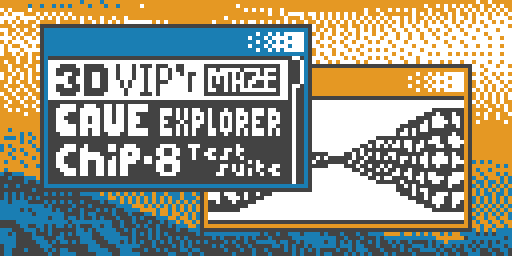
Having this fancy new launcher meant that my old testing code, that just launched several interpreters with fixed settings and ROMs, could be slimmed down to a single subroutine. So we once again actually saved executable memory space while adding a new feature!
Not the first
Around this time I discovered that I wasn’t actually the first to write a CHIP-8 interpreter in CHIP-8. Which makes perfect sense. If I feel attracted to the stupidity of such an idea, surely there are other emulator devs who feel the same. But I had done a Google search before starting the project, and nothing showed up.
But when sharing some more screenshots of Chipception-in-progress on the EmuDev Discord I was told that Geotale wrote a CHIP-8 interpreter in CHIP-8 in 2021. Mad props to Geotale for daring to take up that project and beating me to it!
Lucky for me, their implementation doesn’t do multi-tasking and window management, nor implement SUPER-CHIP. So my project is still unique in those regards, I hope 😉
Finishing the project
The last stretch of this project was mostly fixing lingering bugs and adding
some polish, constantly fighting against the executable memory limit. I managed
to squeeze in a title screen with a nifty animation, a full-screen mode and the
ability to run hires SUPER-CHIP ROMs.
I have a ton of ideas left, but both running into the executable code limit and running into the deadline for Octojam told me that I needed to finish this project up for now.
These ideas were left on the cutting room floor:
- Allow Chipception to read CHIP-8 Binary Format files
- Add some proper memory management and register how much memory each ROM really needs, so we can run more ROMs in parallel
- Have ROMs define their desired window size so not all windows are so similar
- Write some more Chipception-specific ROMs that an OS needs, like a process manager, a calculator, Paint, maybe a “text editor” 😜
- Supporting the XO-CHIP instruction set
All in all, I’m quite happy with how close I’ve come to a “CHIP-8 OS”, in the sense of what I described in the beginning of this dev log! 🎉
Thanks for reading all of this, and good luck with your own projects! 👋
This article was published earlier as a development log on the Github repository for Chipception.
